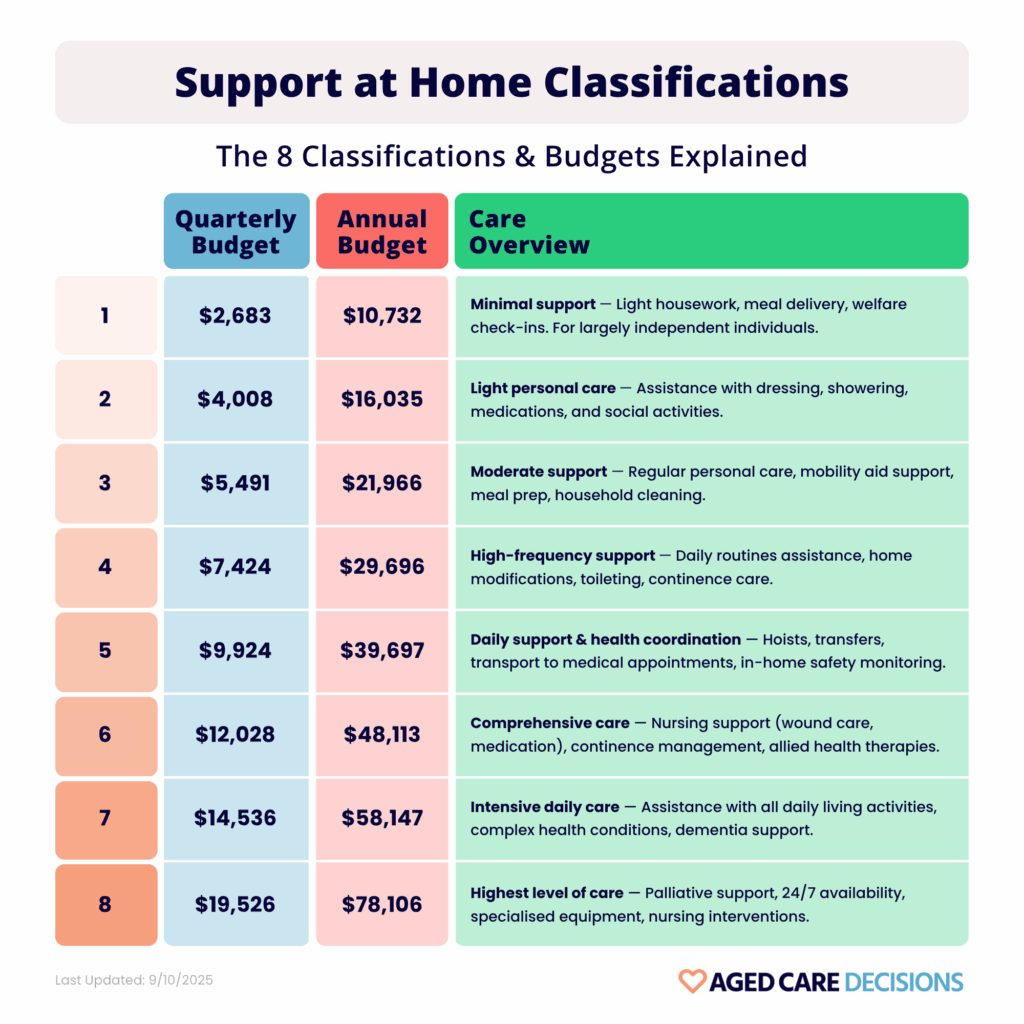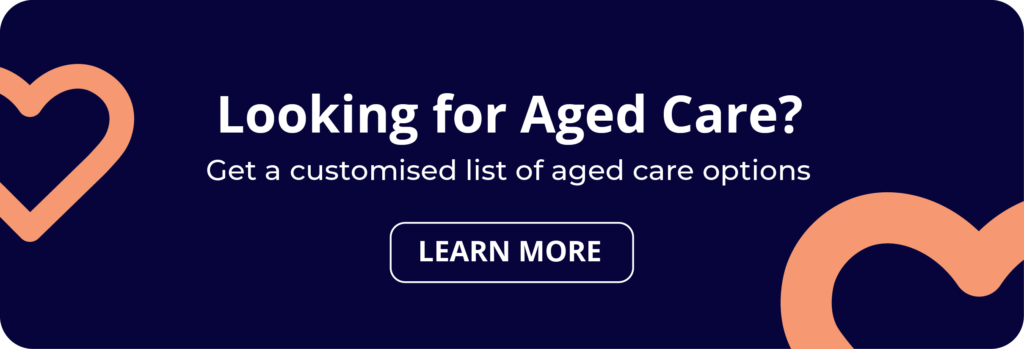From November 1, 2025, the Australian Government’s Support at Home Program will replace the current Home Care Packages (HCP) and Short-Term Restorative Care (STRC) programs.
Table of Contents

Why Move from Four to Eight Classifications?
This new model introduces a more flexible and personalised approach to in-home aged care, with a clear, structured framework of eight care classifications. These classifications ensure older Australians receive the precise level of care needed to remain safe, independent, and well supported at home.
The shift from four Home Care Package levels to eight Support at Home Classifications reflects the government’s commitment to tailoring services more precisely to individual care needs. By offering more detailed tiers, the program better aligns funding and services with a person’s evolving health, mobility, and daily living challenges.
These eight classifications bridge the gap between basic assistance and complex in-home care, ensuring that Australians receive the right type of support at the right time, reducing risks of hospitalisation and premature entry into residential care.
Alongside these ongoing classifications, there are also three short-term care pathways available:
- Assistive Technology and Home Modifications funding tiers
These additions provide greater flexibility for short-term or transitional care needs.
Learn more: Support at Home vs Home Care Packages
The 8 Support at Home Program Classifications – Care Explained
Each classification comes with a defined budget, allocated quarterly and annually, allowing recipients to access approved services tailored to their care needs:
Below is an overview of the types of care typically provided at each classification, alongside the indicative annual funding amounts.

Participants may roll over up to $1,000 or 10% of their quarterly budget if it goes unused. This allows flexibility for larger purchases like mobility aids or home modifications later. However, unused funds beyond these limits will not accumulate indefinitely, encouraging timely use of available support.
If you are receiving a Home Care Package, your funding level will remain the same when you transition to Support at Home.
Below, we breakdown the Support at Home Program Classifications and what each classification provides.
Classification 1 – Minimal Support for Independent Living
Designed for older Australians who are mostly independent, Classification 1 provides occasional assistance with light domestic tasks. Services typically include help with cleaning, laundry, meal delivery, brief welfare check-ins, and transport to medical appointments. This level helps maintain independence while preventing the need for more intensive care in the near future.
Learn more: Support at Home Classification 1
Classification 2 – Light Personal Care and Social Support
Classification 2 offers more regular contact, providing light personal care such as help with showering, dressing, and managing medications. It also supports social engagement through assistance with shopping, meal preparation, and attending community activities. This level focuses on maintaining well-being through gentle, non-intrusive care.
Learn more: Support at Home Classification 2
Classification 3 – Moderate Assistance with Daily Living
At this classification, individuals require more structured support several times per week. Services extend to routine personal hygiene, mobility assistance, meal preparation aligned with dietary needs, and escorted transport to appointments. Household cleaning becomes more frequent, and care plans may start incorporating fall prevention and cognitive support strategies.
Learn more: Support at Home Classification 3
Classification 4 – High-Frequency Personal and Domestic Support
Classification 4 introduces near-daily care across personal and household tasks. This includes regular help with toileting, showering, dressing, and meal preparation, along with home safety assessments that may result in modifications like handrails or non-slip flooring. Housekeeping is provided throughout the week to maintain a safe environment.
Learn more: Support at Home Classification 4
Classification 5 – Daily Support with Health Monitoring
Daily care becomes more intensive, with services covering complex personal care needs such as catheter hygiene, medication management, and physical support (e.g., hoisting). Clients may require transport to ongoing medical treatments and the installation of safety monitoring devices at home. Allied health input becomes more integrated to manage emerging health complexities.
Learn more: Support at Home Classification 5
Classification 6 – Comprehensive Health and Clinical Care
For those with significant health conditions, Classification 6 includes regular nursing care (wound management, injections, glucose monitoring) alongside daily personal care. Allied health services such as physiotherapy or speech therapy become routine. Homes may be modified for medical safety, with specialised equipment supporting mobility and continence care. This level focuses on managing chronic conditions to avoid hospitalisation.
Learn more: Support at Home Classification 6
Classification 7 – Intensive Daily Multidisciplinary Care
Classification 7 involves multiple daily visits from a coordinated care team. Individuals typically need assistance with all daily living activities; feeding, bathing, dressing, transferring, toileting- often due to conditions like dementia or severe mobility limitations. Allied health, nursing, and personal care work together to maintain quality of life and prevent early residential care.
Learn more: Support at Home Classification 7
Classification 8 – Highest Classification of In-Home and Palliative Care
Classification 8 delivers the most intensive home care available, often supporting people with advanced, chronic, or terminal illnesses.
Palliative care is specialised support for people with serious or life-limiting illnesses. It focuses on comfort, quality of life, and support for both the individual and their family.
Key components include:
- Symptom relief – Managing pain, nausea, fatigue, breathlessness, and other physical issues.
- Emotional support – Counselling and mental health care for the person and their loved ones.
- Spiritual and cultural care – Respecting individual beliefs, values, and end-of-life wishes.
- Practical help – Assistance with care planning, legal documents, and daily living needs.
- Care coordination – A team approach involving doctors, nurses, social workers, and more.
- End-of-life care – Ensuring comfort, dignity, and support during the final stages of life.
Palliative care can be provided at home, in hospitals, aged care facilities, or hospices. It aims to help people live as well and as comfortably as possible, for as long as possible.
It is central, with symptom management by nurses and allied health professionals. Care may involve 24/7 monitoring, specialised equipment (hospital beds, hoists, feeding tubes), and overnight support. This classification ensures dignity, comfort, and compassionate care at home through the final stages of life.
Read more: What can I spend my Support at Home package on?
Read more: Support at Home Classification 8
How are the Support at Home Classifications Determined?
Eligibility is assessed through the My Aged Care portal, where applicants undergo an in-home evaluation by the Regional Assessment Service (RAS) for lower Classifications or the Aged Care Assessment Team (ACAT) for higher Classifications. Assessments consider physical health, mobility, cognitive function, living arrangements, and support networks.
Classifications can be adjusted over time through reassessment if needs change due to illness progression, recovery, or injury.
Comparing Support at Home to the Old Home Care Packages
Feature | HCP | Support at Home 2025 |
Levels | 4 (Level 1 to 4) | 8 (Classification 1 to 8) |
Budget Frequency | Annual | Quarterly |
Flexibility | Moderate | Highly flexible |
Unspent Funds | Annual rollover | Limited quarterly rollover |
Provider Transition | Less flexible | Easier to switch |
Service List | Broad categories | Detailed services |
Care Planning | Provider-led | Consumer-driven |
Goal | Provides standardised, basic-to-high support | Provides tailored, timely, and adaptable care at home based on individual needs |
This new model promotes adaptability, transparency, and person-centred care, giving recipients greater control over their home care experience.
What This Means for Participants
- You receive funding that is proportionate to your actual care needs.
- You can be reassessed into a higher classification as your condition changes.
- Those currently on the National Priority System will retain their existing funding level until reassessed under the new framework.
What This Means for Providers
- Providers will deliver care aligned to specific classification budgets.
- Funding will be clearly matched to assessed needs, improving transparency and accountability.
Making the New Classifications Work for You
Navigating the transition to the Support at Home Program can feel overwhelming. However, understanding these eight classifications simplifies the process of selecting services that best meet your circumstances. The goal of Support at Home is not just to deliver care, but to enhance your quality of life, allowing you to age with dignity, comfort, and independence in the place you call home.
If you’re uncertain about your eligibility or the services that might suit your needs, our professional care coordinators can guide you through the process, from assessment to provider selection and beyond.
For further assistance or personalised advice, reach out to My Aged Care for up-to-date resources and guidance. Our service is 100% free, independent and obligation free.







